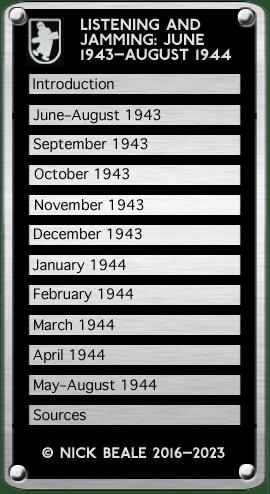 |
||
|
A discussion took place on 4 August between staff officer (Ritterkreuzträger and former U-Boat commander) Kapitänleutnant Hermann Rasch and Hptm. Schmidt of the Luftwaffe’s liaison mission with the naval high command; their topic was provision of aircraft for the Kriegsmarine. The Head of Naval Signals was running a “very wide-ranging and extremely urgent” training programme in the area of maritime tactical radar, including: (a) Trials and tests with radar sets, camouflage and decoy fittings for U- and S-boats; (b) Practical training of operational U-boats, their equipment and servicing teams in the Baltic. If (a) and (b) were to be seen through, there was a pressing need for aircraft to be placed permanently at the Navy’s disposal, the majority of which were able to accept the installation of “radio location and observation devices (e.g. Hohentwiel)”. The inclusion of aircraft in this training was unavoidable since “the enemy airforce is the U-boats’ toughest adversary and with the help of his radiolocation service is currently causing them the greatest difficulties of all”. Like the Luftwaffe, the RAF was investigating electronic emissions over Biscay, using the Wellingtons, Halifaxes and Mosquitoes of No. 192 Squadron for “special duties” flights, staging through advance airfields in Devon or Cornwall. At 1635 (GMT+2) on 11 August P/O E.W. Salter and W/O R.C. Besant took of from Predannack on a “Captain” mission to the Bay but failed to return. Their Mosquito Mk. IV ( DZ375, DT•L) had been shot down by Lt. Gerhard Blankenberg of V./KG 40. Allied monitoring picked up a notification that nine Ju 88 were to take off at 1630 and cross the coast over the Penmarc’h lighthouse in Brittany. F8+HX reported at 1750 that it was attacking and F8+PX followed suit at 1810. Four minutes later the latter machine claimed to have shot down an enemy aircraft in a position about 440 km west of St. Nazaire and was plotted again at 2017 around 70 km west of Penmarc’h; it had landed by 2057. Mosquito DZ375 had been one of the first three allocated to No. 1474 Flight (which became 192 Sqn.) in November 1942, fitted with receivers covering frequencies up to 3000 mHz (= 10 cm wavelength). Blankenberg (Ju 88 C-6, W.Nr. 360382) would be posted missing following an engagement with an American Liberator on 4 September, the British Y-Service heard a report at 1750 that F8+OX had crashed with the probable deaths of its crew.
On 13 August an He 111 was to leave Bordeaux at 2000, cross the coast 10 minutes later, return north of Cap Ferret at 0350 and land at 0400. Meanwhile, an Fw 200 was to take off from the same aerodrome at 2015 and fly south along the coast for 100 km, dropping flares from 4000 m before returning home at 2300. The same day, an Fw 200 (W.Nr. 0221, F8+IT) made contact with convoy SL 134 but was damaged by a Liberator and began to lose fuel. The pilot, Obltn. Günther Seide, was ordered to make for Spain and to jettison its “secret apparatus” (probably Hohentwiel). The aircraft reported that this had been done and, six minutes later, that it was landing at La Coruña. Two machines were again active on the night of the 16/17th, one giving an estimated landing time of 0300 and the other “evidently returning in the early hours.” Presumably on the basis of call signs, the first of these was thought to be the Heinkel from three nights previously while the second was F8+AD (Fw 200 C-6, W.Nr. 0218) of Stab III./KG 40. The night of the 19th brought another Fw 200 flare-dropping sortie, over the bay off Arcachon and lasting two hours; the aircraft on this occasion was thought to be TA+ME (Fw 200 C-5, W.Nr. 203). It was 24 August before another planned He 111 flight was announced, leaving Bordeaux at 2040 and returning north of Cap Ferret just over three hours later. At just over three hours, this was an unusually short sortie and, as was so often the case, no W/T traffic was intercepted to confirm that it took place. An operation six nights later was due to begin at 2100 and the He 111 contacted control, apparently preparatory to landing, at 0540. This was described by Bletchley Park’s Naval Section as “ASV flight by III./KG 40, Bordeaux with 1 He 111.” continued on next page …
|
|||

